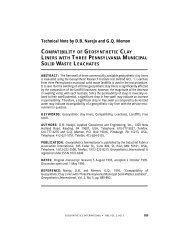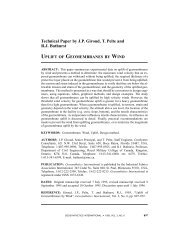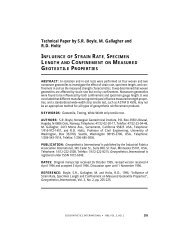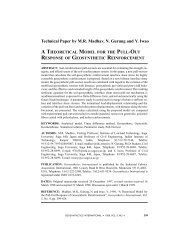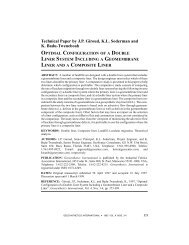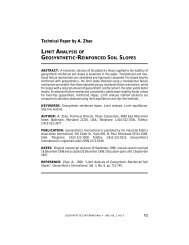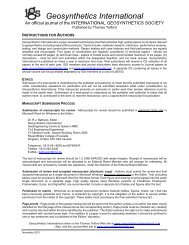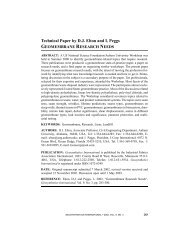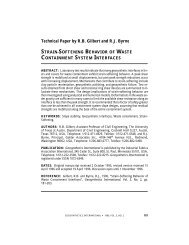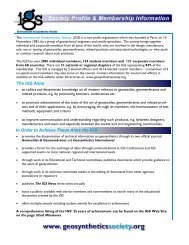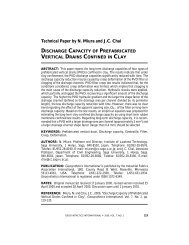leachate flow in leakage collection layers due to defects in ...
leachate flow in leakage collection layers due to defects in ...
leachate flow in leakage collection layers due to defects in ...
Create successful ePaper yourself
Turn your PDF publications into a flip-book with our unique Google optimized e-Paper software.
GIROUD et al. D Leachate Flow <strong>in</strong> Leakage Collection Layers Due <strong>to</strong> Geomembrane Defects<br />
t<br />
avg L<br />
=<br />
A<br />
wmax<br />
Vmax<br />
/cosb<br />
(158)<br />
It should be noted that the notation used for the average <strong>leachate</strong> thickness is t avg L (for<br />
x = L), and not t avg max , s<strong>in</strong>ce a large wetted zone leads <strong>to</strong> a relatively small value (not<br />
a maximum value) of t avg .<br />
Comb<strong>in</strong><strong>in</strong>g Equations 62, 157 and 158 gives:<br />
t = ( 3/ 2) Ls<strong>in</strong>b<br />
avg L<br />
(159)<br />
( + 32<br />
1 2Ls<strong>in</strong> b / t ) / - 1<br />
Comb<strong>in</strong><strong>in</strong>g Equations 10 and 159 gives the follow<strong>in</strong>g equation for the case where the<br />
<strong>leakage</strong> <strong>collection</strong> layer is not full:<br />
t<br />
avg L<br />
=<br />
( 3/ 2) Ls<strong>in</strong>b<br />
32 /<br />
1+ 2Ls<strong>in</strong> b k / Q)<br />
-1<br />
d<br />
o<br />
i<br />
(160)<br />
Comb<strong>in</strong><strong>in</strong>g Equations 17 and 159 gives the follow<strong>in</strong>g equation for the case where the<br />
<strong>leakage</strong> <strong>collection</strong> layer is full:<br />
t<br />
avg L<br />
=<br />
L<br />
N<br />
M<br />
1 +<br />
t<br />
LCL<br />
( 3/ 2) L s<strong>in</strong>b<br />
4 L s<strong>in</strong>b<br />
F Q<br />
1 +<br />
2<br />
kt<br />
HG<br />
LCL<br />
O<br />
I<br />
KJ<br />
Q<br />
P<br />
32 /<br />
- 1<br />
(161)<br />
5.1.4 Leachate Thickness <strong>in</strong> Case II<br />
Case II (Figure 13b) is a case that may frequently occur. S<strong>in</strong>ce it is not easy <strong>to</strong> develop<br />
an analytical solution for this case for the reasons <strong>in</strong>dicated <strong>in</strong> Section 5.1.1, an <strong>in</strong>terpolation<br />
method is proposed.<br />
The limit situation between Cases I and II (Figure 13) is illustrated <strong>in</strong> Figure 14a. This<br />
situation occurs when:<br />
<strong>to</strong><br />
F mI x = L - = L 1 - K J<br />
(162)<br />
2 s<strong>in</strong>b 2<br />
HG<br />
Comb<strong>in</strong><strong>in</strong>g Equations 154 and 162 gives:<br />
L s<strong>in</strong>b<br />
5<br />
-<br />
3 <strong>to</strong><br />
<strong>to</strong><br />
18<br />
tavg lim<br />
=<br />
32 /<br />
2 F 2 L s<strong>in</strong>bI<br />
t<br />
HG<br />
o<br />
KJ<br />
(163)<br />
260 GEOSYNTHETICS INTERNATIONAL S 1997, VOL. 4, NOS. 3-4



